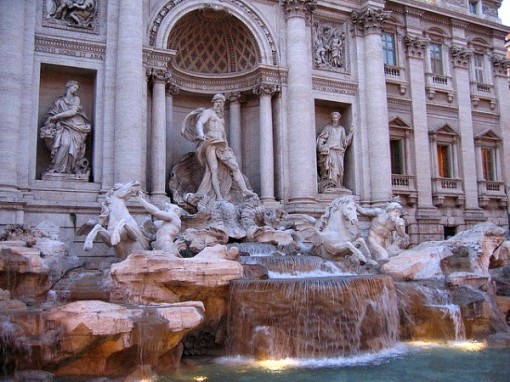Fontana di Trevi, better known to most of us as Trevi Fountain, is Rome’s most spectacular and popular fountain. In a city with so many impressive fountains, that’s a pretty big claim.
The Baroque-style fountain, designed by architect Nicola Salvi and completed in 1762, is located in a busy section of the city, not far from the popular Via del Corso. To get to the fountain you walk down narrow streets, some of which seem more like alleys than streets, to the historic center of Rome. There’s signage to help you find the way, and asking for directions will help get you pointed in the right direction, but if you find the noise gets louder and louder it means you’re getting close.
When I first stepped into the Piazza di Trevi, its intricate sculptures, cascading water, and faded stones wowed me. Against the backdrop of the fountain is a large sculpture of Oceanus in the center, along with chariot in the shape of a shell drawn by seahorses. Additional sculptures flank each side of Oceanus, resting in the niches. In the water are additional sculptures representing sea creatures, both real and mythological. At about 85 feet high and 65 feet wide, Trevi Fountain is a tribute to the power and lushness of the sea, both in its design and in the roaring water spilling over the rocks.
I spent some time at Trevi Fountain during the afternoon as well as in the evening. It was always abuzz with people, albeit primarily tourists, and the constant clicking of cameras could be a bit distracting. But still, there was a certain energy about it as visitors posed, as did I, throwing a coin into the fountain.
There are a couple of variations on the coin throwing story, all rooted in tradition with varying interpretation. The most popular interpretation is that throwing a coin over your shoulder into the water of the fountain will ensure a return visit to Rome. A current version of this tradition is throwing three coins with the right hand over the left shoulder. This tradition of three coins probably comes from the movie Three Coins in the Fountain. (In the movie, however, it was three different women each throwing one coin into the fountain.) Still another version of the tradition is that throwing two coins will ensure a marriage coming soon, and three coins means a divorce.
I opted for one coin, throwing it into the fountain with my right hand over my left shoulder – why tempt fate, after all. It’s seems to have worked as I’ve been back several times since that first visit.
Whatever the interpretation, thousands of visitors throw coins every day, and it’s estimated that over $4,000 a day is collected from the fountain. The funds are used to support needy projects around Rome.
- In Three Coins in the Fountain (1954), three American roommates working in Italy wish for the man of their dreams after throwing coins into Trevi Fountain.
- In La Dolce Vita (1961), you see Anita Ekberg jumping into the fountain (fully clothed), inviting Marcello Mastroianni to join her.
- In the Lizzie McGuire Movie (2003), Hillary Duff graduates from middle school and vacations in Italy.
Despite the crowds, the noise, and the tendency to dismiss visiting Trevi Fountain as too touristy, I loved its glow in the evening. It was most special during that golden hour, when day turns to night in a wash of color, and the lights on the fountain start coming on. It was beautiful and romantic, and I didn’t care if there were hundreds of other people around thinking that very same thing.
Location: Piazza di Trevi. The narrow streets, few of which are straight or set up on a grid, can be confusing.
Photo credit: personal collection


